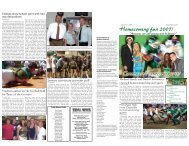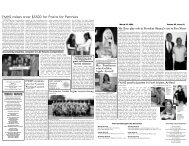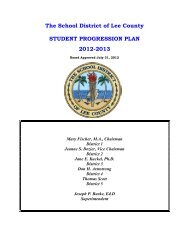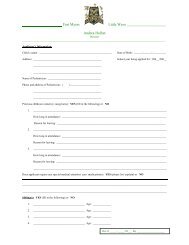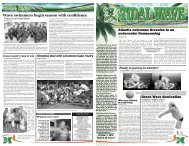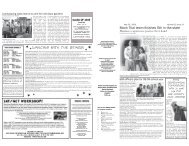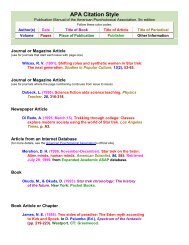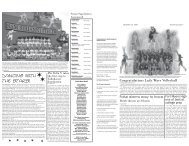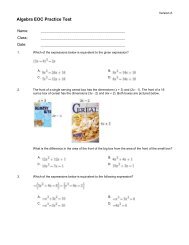SUMMER READING – 2013 – RISING IB SENIORS
SUMMER READING – 2013 – RISING IB SENIORS
SUMMER READING – 2013 – RISING IB SENIORS
You also want an ePaper? Increase the reach of your titles
YUMPU automatically turns print PDFs into web optimized ePapers that Google loves.
<strong>SUMMER</strong> <strong>READING</strong> <strong>–</strong> <strong>2013</strong> <strong>–</strong> <strong>RISING</strong> <strong>IB</strong> <strong>SENIORS</strong><br />
Dear Rising <strong>IB</strong> Seniors,<br />
We are gearing up for next year and are eagerly awaiting your arrival! In order to come prepared for <strong>IB</strong> English IV<br />
in August, you will need to complete the following summer reading project:<br />
Read In Cold Blood by Truman Capote (ISBN 978-0-679-74558-7) and complete the attached five-part<br />
assignment. The first and second assignments include a “Who’s Who” character chart (10 points) and a venn<br />
diagram with written analysis comparing and contrasting Dick and Perry (10 points). The third part, a journal<br />
assignment (10 entries each of a minimum of one side of a college-ruled piece of notebook paper), gives you options<br />
from which to choose and will assist your comprehension of the text (40 points); textual evidence with page numbers<br />
(citations) should be provided for all journal responses. The final two pieces (20 points apiece) involve creating a<br />
mind-map of Truman Capote’s life and then reading and reflecting upon a news article from the last five years that is<br />
linked to the real-life murder investigated by Capote in his riveting nonfiction novel, In Cold Blood.<br />
All of these summer assignments must be completed by hand; no typed assignments will be accepted. You will be<br />
required to submit your work in a pocket folder with brads and will be tested on all of the above during your first<br />
English class of the year. You should arrive on the first day of class with these assignments enclosed in the<br />
aforementioned folder and your copy of In Cold Blood. Should you lose this packet, you may access this assignment<br />
through the school website.<br />
Additionally, <strong>IB</strong> English IV requires you to have several pieces of literature that do not appear in your school-issued<br />
literature textbook. You may want to secure these works ahead of time so you have them when necessary throughout<br />
the school year. The required supplementary texts are listed below so that you may plan ahead:<br />
Hamlet <strong>–</strong> Shakespeare 074347712X<br />
Wuthering Heights <strong>–</strong> Brontë 0-451-52925-1<br />
In the Lake of the Woods <strong>–</strong> O’Brien 9780618709861<br />
The Penelopiad <strong>–</strong> Atwood 978-1-84195-798-2<br />
The Signet Classic Book of Mark Twain’s Short Stories <strong>–</strong>Twain 978-0-451-53016-5<br />
If you are not financially able to supply these texts, please let one of us know in the fall, and we will take care of it<br />
for you confidentially.<br />
We are looking forward to a great year!<br />
Sincerely,<br />
Mrs. Stewart and Mrs. Tomlinson
In Cold Blood Truman Capote (ISBN 978-0-679-74558-7)<br />
Reading Comprehension: Preview this study packet by section, and then handwrite your answers to all work. Though<br />
your chart descriptions do not need to be in complete sentences, the rest of your work (the answers to all of the journal<br />
assignments) DO need to be written in complete sentences and should include textual evidence, along with the page<br />
number, where deemed appropriate. Where multiple questions are posed, please be sure to address all of them in your<br />
answer.<br />
**All responses must be complete and a minimum of one full page (college-ruled paper), one sided. Rewriting the journal<br />
assignment instructions and/or rewriting a key passage for do not count toward the required length of the response. Do<br />
not type your answers.<br />
Bobby Rupp<br />
Vic Irsik<br />
Gerald Van Vleet<br />
Bob Jones<br />
Paul Helm<br />
Mrs.Helm<br />
Susan Kidwell<br />
Part I: Who’s Who in Truman Capote’s In Cold Blood<br />
As characters are introduced and developed, complete the following charts:<br />
Name Description<br />
(Physical/Personal Traits)<br />
“physical characteristics unspecified”<br />
“physical characteristics unspecified”<br />
“physical characteristics unspecified”<br />
Relevance<br />
(role, important actions, words etc.)
Mrs. Hideo Ashida<br />
Bob Johnson<br />
Alfred Stoecklein<br />
Mother Truitt<br />
Mrs. Myrtle Clare<br />
Alvin Adams Dewey<br />
(80)<br />
Harold Nye (85)<br />
Floyd Wells (91)<br />
Willie Jay<br />
Cookie<br />
Marie, Paul, and Alvin<br />
Adams Dewey, Jr.<br />
Mrs. Archibald William<br />
Warren Brown<br />
The Hartmans<br />
“physical characteristics unspecified”
Wendle and Jose Meier<br />
Logan Green<br />
Jolene Katz<br />
Larry Hendricks<br />
PART II: Complete the Venn diagram below, comparing and contrasting Dick and Perry. Then handwrite a two (2) page<br />
analysis (one page of college-ruled notebook paper, front and back) of your findings, providing direct evidence from the<br />
text; evidence quoted directly should include page number citations.<br />
Dick (Richard) Hickock Perry Smith
PART III: Truman Capote’s In Cold Blood (10 points each = 100 points)<br />
Choose and complete ANY 10 of the following 15 assignments. ALL responses to the following questions must be HANDWRITTEN! These<br />
pages are from the ISBN 978-0-679-74558-7 edition. If your edition is different, you will need to divide your own pages into 15 equal<br />
sections. Handwrite the answers as you read <strong>–</strong> Do NOT type your answers.<br />
**All responses must be complete, include textual evidence (along with page number) where deemed appropriate, and<br />
must be a minimum of one full page, one sided. Rewriting the journal assignment instructions and/or rewriting a passage<br />
for analysis do not count toward the required length of the response. Do not type your answers.<br />
Journal<br />
Entry #<br />
1<br />
2<br />
3<br />
4<br />
5<br />
6<br />
7<br />
Page # **Journal Assignment Instructions<br />
1-24<br />
Part I<br />
24-55<br />
Part I<br />
55-74<br />
Part I<br />
77-100<br />
Part II<br />
100-123<br />
Part II<br />
123-152<br />
Part II<br />
152-179<br />
Part II<br />
and III<br />
SETTING: The first pages of the book introduce key elements of the setting of Holcomb, which<br />
are essential to understanding Capote’s focus on journalistic details. Using bullets or phrases, LIST<br />
at least 10 key descriptions that identify the setting of the novel (which include references to time,<br />
place, region, atmosphere) and cite the page # for each description. Once you have your list,<br />
answer the question providing textual evidence:<br />
“What aspects of this setting might influence the characters, their behavior, and what might happen to<br />
them?” Be specific.<br />
POINT OF VIEW: Authors make a conscious decision about how they will tell the story. Capote<br />
tells the story from two alternating points of view <strong>–</strong> the Clutters and the murderers. First,<br />
identify two (2) examples of each of these points of view (along with reference).Then,<br />
comment on the effect of this structure and the absence of Capote’s voice in the narrative. You<br />
may refer to elements of previous pages, but you must use some details from this section.<br />
CHARACTER: Rather than a fictional protagonist with an antagonist and minor characters, this<br />
novel has an entire cast of characters, who are all very real people. Even so, Capote does not<br />
present them as objectively as a journalist might; he builds complex characters, more fictional in<br />
presentation than journalistic. List members of the Clutter family and at least four (4) other<br />
victims. Include at least one (1) detail that personalizes them (textual evidence and page #).<br />
KEY PASSAGE: Choose a striking or key passage from this section that you think is important to<br />
character development, plot development, or meaning <strong>–</strong> a passage may be a line, quote, or any<br />
excerpt from the novel. Copy the passage correctly (use quotation marks, cite p. #).<br />
Using complete sentences, answer the following questions:<br />
Why is this a key passage? What does this passage reveal about…development of a character (a<br />
significant change or description)? …a development in the plot? … or the meaning of the work<br />
as a whole?<br />
RHETORIC: Find 1 example of parallelism inside a sentence and explain how it connects the two<br />
elements and what its effect is on the meaning of the novel. Then, find one (1) example of<br />
repetition and explain its use and effect on meaning.<br />
PERSONAL RESPONSE: Imagine that you have been appointed a lawyer for Dick or Perry. In a<br />
one-page journal entry, briefly describe what your defense would be <strong>–</strong> not in legal terms <strong>–</strong> but in<br />
terms of how you might convince the jury not to give them the death penalty, or mitigate their<br />
punishment in some way.<br />
SYNTAX: Choose one (1) paragraph from this section and do a syntactical analysis by<br />
constructing the following chart.<br />
First 4 words<br />
in each<br />
sentence<br />
Verbs<br />
(list all)<br />
Figurative<br />
language or<br />
imagery<br />
Repetition /<br />
parallelism<br />
# of words in<br />
sentence<br />
Then, answer each of the following questions in complete sentences:<br />
What do you notice about the sentence beginnings? What conclusion can you draw about the<br />
verbs used? How does the author make use of literal and/or figurative language? What kinds of<br />
images does he appeal to in this paragraph? How does the repetition or parallelism affect<br />
meaning? What observation can you make about sentence length and variety?(use textual evidence<br />
where appropriate)<br />
8 180-207 DICTION: Choose one (1) page from this section and choose 10 words from that page. Label each
9<br />
10<br />
11<br />
12<br />
13<br />
14<br />
15<br />
Part III word as having a positive connotation, negative connotation, or as neutral. Then, using all 10<br />
words you have studied, answer the following question:<br />
207-231<br />
Part III<br />
232-262<br />
Parts III<br />
and IV<br />
263-302<br />
Part IV<br />
302-321<br />
Part IV<br />
321 -<br />
343<br />
Part IV<br />
Whole<br />
Novel<br />
Whole<br />
Novel<br />
What do these words reveal about the narrator’s attitude?<br />
FIGURATIVE LANGUAGE: Authors use figures of speech because of their power and their<br />
layers of meaning, (e.g. we say, “It’s raining cats and dogs” instead of “It’s raining large drops<br />
which are coming down very fast and hard.”) Choose three (3) to five (5) figures of speech from<br />
this section and write them out. Then, identify the type of figure of speech. Lastly, explain the<br />
layers of meaning by discussing how each is used for meaning and effect.<br />
Think about the following questions:<br />
Why did the author use this figurative image instead of something else? What does this<br />
comparison/figure of speech do that literal language would not accomplish? What layers of<br />
meaning does it suggest?<br />
IMAGERY: It is important in the novel for the readers to see characters, motivation, events,<br />
places, etc. as ―”real.” Authors use imagery (details that appeal to the 5 senses) to draw the reader<br />
into the experience of the novel. Choose 5 images from this section and tell what sense(s) they<br />
appeal to. Explain how each of these images affects the reader during this section.<br />
PERSONAL RESPONSE: Imagine you are a character in the novel (human or animal). Write a<br />
two (2) paragraph letter to another character in the novel. Make references to at least three (3)<br />
specific images, events, or details of this section. You may refer to past events, but focus your<br />
details on this section.<br />
**TEXT TO GRAPHICS—CREATE A VISUAL: Choose a passage and create a graphic<br />
representation of the text, paying close attention to details. You may use literal or symbolic<br />
representations, abstractions, color, shape, form<strong>–</strong>but make sure that everything you include has<br />
meaning and can be traced back to specific references to the text. Include a significant quotation<br />
from the passage at the bottom of the page.<br />
You may create the visual in any way you see fit. In a short paragraph, you should explain your<br />
choice of graphics, color, shape, etc. and the textual references that inspired them.<br />
CHARACTER: "There is not much point in writing a novel unless you can show the possibility of<br />
moral transformation, or an increase in wisdom, operating in your chief character or characters."<br />
(Anthony Burgess) Since so many stories contain lessons that the main character learns and grows<br />
from, critical readers pay attention to the meaning associated with how and why characters change<br />
and develop throughout the novel.<br />
Choose one (1) dynamic character you believe changed throughout the work. Explain HOW<br />
they developed/changed (what has he/she learned?), WHY the character changes (causes), and<br />
WHAT those changes suggest about the meaning of the novel.<br />
THEME/BIG IDEA: Explore Capote’s ideas about two (2) of the following In Cold Blood: (a)<br />
human nature and evil, (b) justice and punishment, (c) nature vs. nurture (naturalism), or (d) fate v.<br />
free will. In a two page response, explain his position and how he argues his position on each idea<br />
through the plot, the setting, the characters, and his writing style.<br />
CREATIVE RESPONSE: Choose one (1) of the following:<br />
(a)Take a scene from the book and write it in poetic form<br />
(b) Write the first page of a new chapter in the book<strong>–</strong>either a prequel or sequel chapter—imitating<br />
Capote’s style as you write.<br />
This study guide is a modified version of a guide found online at<br />
http://www.xaverian.org/uploaded/academics/Summer_School/Senior_English_Electives_Summer_Reading_2011.pdf (Xaverian High School)
In Cold Blood Truman Capote (ISBN 978-0-679-74558-7)<br />
Part IV : Mind Map Assignment <strong>–</strong> Truman Capote<br />
Objective: Create a Mind Map representing the life of In Cold Blood author Truman Capote.<br />
Definition of Mind Mapping: Mind mapping is an organizational thinking strategy used to literally “map<br />
out” your thoughts; think of it as a creative alternative to note-taking. The process is simple—as you think<br />
about information you’re gathering, you map out instant associations using key words, pictures, symbols,<br />
and icons. Mind mapping is both easy and effective because your brain works by association; it naturally<br />
likes to link things together.<br />
How to Complete This Assignment: First, review the mind mapping steps (below). View the sample (and<br />
view more examples online, if needed). Then, research the life of Truman Capote by reading the<br />
biographical information on this website:<br />
http://www.kcfb.info/archive_ksreads/ksr_2008_cblood/biography.htm.<br />
As you/after you read about Truman Capote, create an effective mind map that represents his life.<br />
Grading Criteria: Mind map must accurately and completely capture biographical infromation about<br />
Truman Capote via a minimum of five first-level branches and 20 additional branches (10 points) , be<br />
visually stimulating and appealing (5 points), and be accompanied by a “key” on the reverse of the<br />
map that explains in bullet list format the meaning behind the symbols, drawings, and icons on the<br />
map (5 points).<br />
Mind Mapping Guide<br />
Step 1 <strong>–</strong> Creating your central idea<br />
Create your central idea as the theme (“center”) of your Mind Map. The center of your map should ideally<br />
be/include an image related to your central idea, as images help you imagine and remember information.<br />
Step 2 <strong>–</strong> Adding your ideas<br />
You next need to add your ideas and thoughts to your Mind Map. You can do this by adding branches for each of<br />
your ideas. Curved, natural branches are the most effective as they reflect how you brain thinks. Straight lines<br />
don’t excite your mind, which means that you aren’t soaking up so much information. Curved lines create variety<br />
and excitement for your eyes, making the information they hold easier to remember! Give your main ideas thicker<br />
branches to show their importance. Your branches should become less and less thick as you add your second and<br />
third level ideas.<br />
Step 3 <strong>–</strong> Using color<br />
A very important part of Mind Mapping is color. Colors are as exciting to your brain as images. They add extra<br />
interest and life to your Mind Map and give energy to your creative thinking.<br />
Step 4 <strong>–</strong> Using key words<br />
Once you have created a branch for your idea, you can add a word to describe this idea. It is important that you try<br />
and only use single words (or, at most, short key phrases) rather than long<br />
descriptions. This is because an isolated word will allow you to create many more connections than two or more<br />
words. This allows your mind to have the freedom to spark off new ideas and thoughts.<br />
Step 5 <strong>–</strong> Using images
Attach visual images to your branch. Images have a lot of power on your brain; the more you use, the better!<br />
Images can, and sometimes should, even take the place of words on your branches.<br />
Step 6 <strong>–</strong> Making connections and associations<br />
Carry on creating your Mind Map! Make connections from your first idea to other ideas, and let your brain start<br />
making associations with other thoughts you have. These connections will start forming the rest of your main<br />
branches and then your second level branches and then third level branches. For each new idea, create a branch<br />
from the branch you were thinking about. If you connect branches and, therefore, ideas, you will understand and<br />
remember information a lot more easily.<br />
Sample for Marie Curie:<br />
Sample for William Shakespeare:<br />
Adapted from imindmap.com
Part V: “In the News” Assignment <strong>–</strong> The Art of Non-Fiction<br />
Objective: Find a recent non-fiction article (from within the last five years) related to the investigation of<br />
the murder investigated in In Cold Blood; summarize it in one page and then write a one-page reflection of<br />
how this more recent information affects your interpretation and/or emotional response to Capote’s “nonfiction”<br />
novel.<br />
How to Complete This Assignment: First, read In Cold Blood. Then, use the Internet to locate a news article about<br />
the investigation of the murder covered by the book. The article should have been published within the last five<br />
years and reflect knowledge not known and/or not represented in the original work. The article should be a<br />
minimum of 350 words in length. Print a copy of the article to hand in with your finished assignment. After<br />
reading and studying the article, handwrite a summary of the facts contained within it (minimum one page). Then,<br />
handwrite your personal reflection in which you explain how and to what extent the article affects, enlightens, and<br />
or changes your assessment of Capote’s work. (Does the article make you question any of Capote’s “facts”?<br />
Does it make you question what he chose to leave out or chose to include and why? Does it make you question<br />
any of Capote’s investigative strategies? Does it impact your overall impression of the book?)<br />
Grading Criteria: Submission must include a hand-written one-page summary of a news article (minimum<br />
350 words in length and hard copy included with the assignment) (10 points) as well as a hand-written onepage<br />
reflection (10 points).



